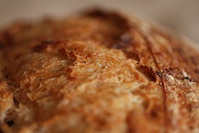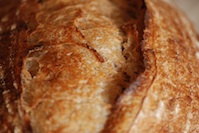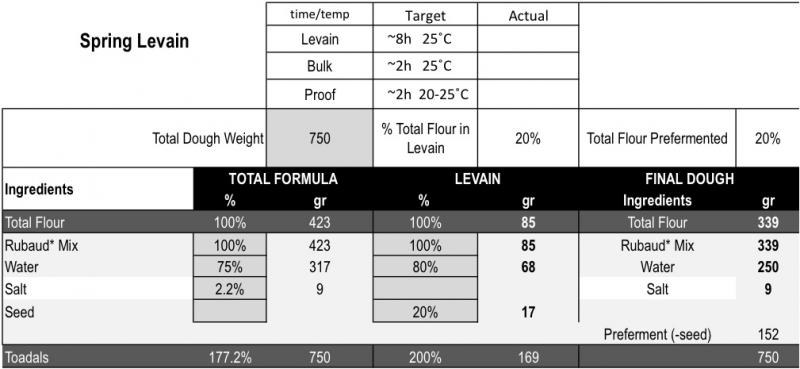Springtime is outdoor time. Meaning less baking time :-(. So I'm pleased to have worked up this 36h labor-lite levain. It has very satisfyingly complex flavor, surprisingly light crumb and an irresistible crust when baked boldly. Prep is facilitated by using the same flours (a modified Rubaud mix) for both levain and dough. Many thanks to Ian(ArsP) via PiPs for novel (to me) process pointers.

Click the table below to go to a working Google spreadsheet
First Morning
1. Mix final levain build in 25˚C (77˚F) water. Incubate @ 25˚C (77˚F). If possible (not essential), aerate levain and let rise 1-2X before using.
2. Mix final dough's flours in RT water. "Enzymatically preferment" at 20-22˚C (68-72˚F).
First Evening
3. Mix salt and levain into autolysed flour with pincer & FF until dough comes together.
4. Bulk ferment ~2h @ 25˚C (77˚F) w/2-4 folds early. Rest, shape & refrigerate.
Second Evening
5. Proof 1-2h @ 20-25˚C (68-77˚F).
6. Bake 20' @ 230˚C (450˚F) w/steam, then 12' @ 215˚C (420˚F) with convection (watch it), longer for loaves > 750 gr.
The "Rubaud*" flour mix is a slight modification of Gerard Rubaud's formula. My "*" version is
35% AP
25% Bread Flour
30% Whole Wheat
7% Spelt
3% Rye
The process exploits Ian(ArsP)'s "enzymatic preferment" during Day 1. In theory, this saltless soaker is intended to release free amino acids by proteolysis from seed storage proteins, enhancing Maillard activity in the oven. It also performs as much conventional autolyse as any dough could ask for. Aerating the levain (stirring it down) releases more free amino acids in the levain, and it's interesting to see it grow back up, in the couple of bakes (weekends) where I actually had a chance to do that.

As Ian(ArsP) points out in his blog, it's convenient to start the levain build and enzymatic preferment at the same time. Easily done before leaving for work in the morning. Mixing, folding and bulk are performed that evening, with the dough rested, shaped and refrigerated before bed. The dough moves slowly during the 24h fridge retard, but comes back to life when retrieved to warm up while the oven is doing the same, or a bit longer.




Earlier bakes (below) with this process were at 78% hydration. Cutting back to 75% unflattened the profile nicely.



This one's a keeper. I'm anxious to apply this process to formulae I've previously come to know and love.
Happy Baking and Happy Spring!
Tom
- Our Crumb's Blog
- Log in or register to post comments

This looks great!
What is RT water?
Thanks ml. Sorry about the cryptic abbreviation. Crept in from my day job (bio lab research). Lab notebook shorthand.
Of course, "Room Temperature" can mean anything from 66˚F to 84˚F around here, Winter/Summer. So what I mean by that is "don't bother to heat it up to 77˚F (25˚C) since it's going to sit out in the kitchen all day anyway". That said, I haven't followed this process during a day when our kitchen gets to 84˚F (coming up soon), so that should be interesting.
Cheers,
Tom
Loverly!
-Floyd
And your pain japonaise aux raisin looks totally addictive. Nothing quite like raisin bread(s).
Thanks for commenting.
Tom
Now can you explain the difference between an ArsP enzymatic preferment and the much more familiar term soaker? I see someone else has asked about RT. Now what about FF? In any case, looks delicious. -Varda
Sorry about that Varda. I need to strip out those abbreviations when I post (there's an app for that, for sure).
Good question about Ian(ArsP)'s "enzymatic preferment". One practical difference, from my limited experience, is the absence of salt from his preferment. Now, I'm engaging in some baker's doublethink now because I make Peter Reinhart's 100% WW sandwich bread >=once/week and I dutifully include 1.8% salt in the soaker there, because PR says its needed to keep enzymes in check (not all enzymes are going to be that sensitive to higher ionic strength of 1.8% NaCl but his empirical experience is talking). You better believe I'm going to omit that salt from the soaker in one of my upcoming PR WW bakes to see what happens. Ian(ArsP) is inviting those enzymes to free amino acids by keeping ionic strength to a minimum. Allows autolyse chemistry to occur as well, of course.
I'm sure others with more diverse than my narrow experience with soakers may have other views on this. The "enzymatic preferment" does seem to soften the hard bits of the formula's 40% whole grains. I'm anxious to try it with 50% and above.
Thanks for the comment.
Tom
figure out the difference between an autolyse, enzymatic preferment and and a soaker. A soaker for me is something you want to soak that isn't a flour IE; seeds, bran, oats, Toadies......I autolyse flours all the time, for nearly every bake up to 12 hours sometimes, with salt and sometimes without even though an autolyse is supposed to be without salt from what I have read. I have no experience with enzymatic preferment. Are EP's for flour or for the levains or both? We routinely build levains and stir them them down at least twice if doing a 3 stage build over 6-12 hours depending upon how active they are at the time. I suppose it is more interesting for me if it is understanding less by ignorance on my part.
Your bread suffers none for my misunderstanding. I think Toadies would help the flavor some they were invented in time for this recipe to be published and that is definately your fault for not being more punctual :-) Very nice bread Tom and it has to taste great even with out the Toadies.
Happy Baking